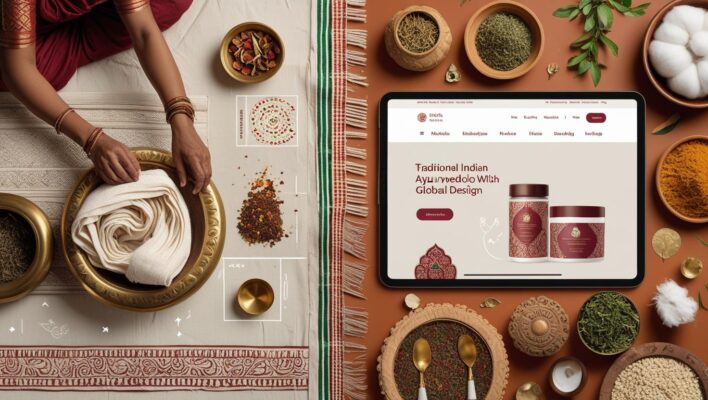

Branding Ayurveda, Textiles & Handicrafts: How to Make Traditional Products Feel Global
🪔 Introduction: The Indian Tradition Goes Global
Ayurveda, handwoven textiles, and artisan handicrafts have long been treasures of Indian culture. In 2025, they’re more than just heritage—they’re business opportunities on a global scale. International consumers crave authenticity, sustainability, and craftsmanship. And few countries deliver this better than India.
But here’s the catch: many MSMEs in these sectors struggle to translate their rich cultural value into a brand that looks global, feels premium, and resonates across borders.
At Sterling Arcus, we believe you don’t have to westernize your identity to scale — you just need to modernize the way your story is told.
🎯 Challenge 1: Looking Premium Without Losing Identity
One of the most common missteps we see? Trying to mimic luxury brands from the West — sterile packaging, generic names, or clichéd slogans that strip away the soul of the product.
What global buyers want isn’t just polish — they want meaning.
- Ayurveda buyers care about sourcing, purity, and ancestral wisdom.
- Textile lovers want to feel the loom’s rhythm and the region’s history.
- Handicraft enthusiasts seek unique expressions, not mass-market replicas.
👉 Authenticity isn’t a roadblock — it’s your edge. Your job is to preserve the soul while refining the surface.
🧵 Challenge 2: Making Storytelling Tangible
Every traditional product has a compelling backstory. But most MSMEs struggle to express it in a brandable, repeatable, and visual format.
Here’s how we help our clients anchor storytelling into brand assets:
- Ayurveda Brands: Highlight formulation rituals, key herbs’ sourcing locations, and their effects. Use infographics or QR codes on packaging for story-driven browsing.
- Textile Brands: Build your catalogue like a map — connecting weavers, motifs, and regions. Let your customers “wear the story.”
- Handicrafts: Give each product a lineage. Use artisan bios, process documentation, or even short behind-the-scenes videos to elevate perceived value.
🔑 Remember: The origin is your intellectual property. Let your story become your brand’s IP.
💻 Challenge 3: Digital Aesthetics for Traditional Products
Your digital face—website, product photography, and social media—must feel contemporary to be taken seriously by today’s buyers. But that doesn’t mean losing the warmth of your roots.
At Sterling Arcus, we focus on:
- Typography: Pair elegant serif fonts with regional scripts or Sanskrit subtext for a dual-language aesthetic.
- Color Palette: Use muted earth tones, gold foils, or off-whites that suggest heritage without overwhelming the screen.
- Photography: No over-edited stock images. Use natural light, rustic backgrounds, and close-ups of texture and detail.
- Packaging: Blending minimalism with meaningful symbols — whether it’s kolam patterns, sacred geometry, or local flora.
The result? A brand that feels credible to an urban buyer in Mumbai and premium to a customer in Berlin.
🧭 The Sterling Arcus Playbook: Modernizing Tradition Without Compromise
Our approach to branding traditional Indian products follows a structured yet fluid method:
- 🧬 Origin Audit
Understand your product’s geography, raw materials, cultural significance, and production process. - 📝 Brand Narrative Building
Create a compelling “why” and brand story arc — from ancestral roots to modern relevance. - 🎨 Identity System Design
Develop logo, fonts, color palette, iconography, and packaging that reflect both elegance and authenticity. - 🌐 Digital Presence Buildout
Design your website, catalog, marketplace profiles, and UX that encourages trust and repeat visits. - 🧳 Global-Ready Marketing Collateral
Create brochures, decks, and campaigns that work across cultures and platforms — from domestic retail to export catalogs and exhibitions.
🖼️ Mini Inspirations: Who’s Doing It Well?
- Forest Essentials: Makes Ayurveda aspirational, not alternative — packaging luxury with lineage.
- Okhai: Celebrates rural artisans while offering modern silhouettes.
- FabIndia: Built an empire by making tradition stylish and accessible — without ever leaving its roots.
What these brands have in common: clarity of story + consistency of design.
🧘♀️ Conclusion: Global is a Format — Not a Geography
Going global doesn’t mean abandoning what makes you Indian. It means refining your presentation, sharpening your story, and packaging your product with confidence.
Traditional Indian MSMEs don’t need to become like global brands.
They already are global — they just need the right lens to show it.
📣 Let’s Talk
If your product carries Indian tradition, we can help it travel the world — without losing its soul.
Book a brand consultation with Sterling Arcus →
Would you like this blog also formatted for WordPress upload (H1, H2, SEO meta title, etc.), or turned into a LinkedIn carousel version as well?



